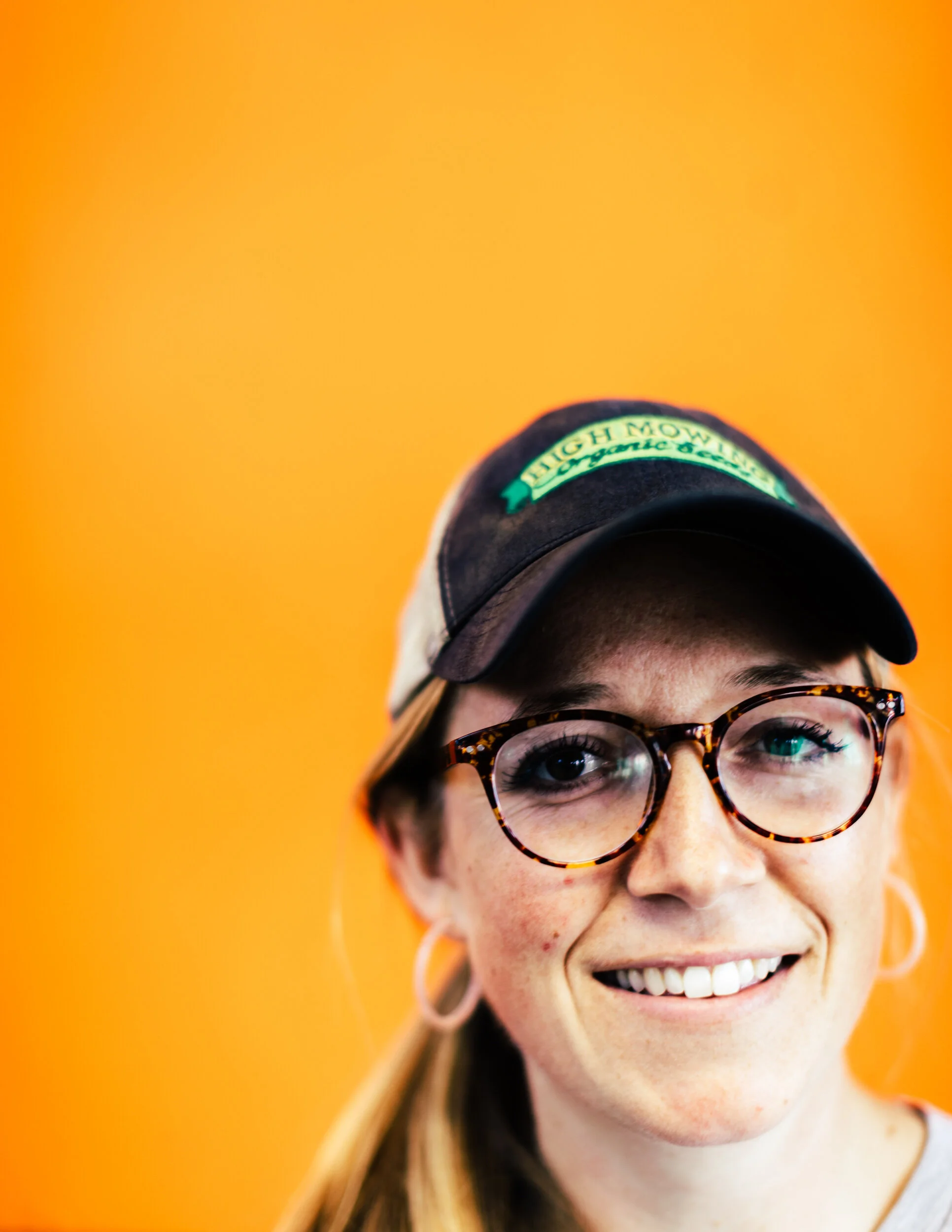The Hospital Rooftop Farm
Photos by Michael Piazza
One evening during this summer of record high temperatures I went on a free public tour of a large rooftop farm in the heart of our fair city. To reach this destination, I took the orange freight elevator three stories up at the power plant building of Boston Medical Center (BMC). The farm, which yields produce for the hospital’s patients and staff during New England’s brief growing season, has already received a fair bit of press. So, this was not some secret oasis. Yet the sight of the greenery, in the middle of a brick-and-concrete jungle, took my breath away. It also had me breathing fresh air in greedy gulps.
Lindsay Allen, farm manager at BMC, ushered us into the lush, green space. Thanks to a slight breeze, nasturtium, calendula and other edible blossoms seemed to be nodding their heads in greeting. About two dozen varieties of plants—herbs, leafy vegetables and fruits—were thriving in planters arranged in neat rows over a carpet of AstroTurf. We might have missed the two brightly painted wooden bee boxes whose residents help pollinate crops in this mini ecosystem, but Allen pointed them out to us. “Bees are the unsung heroes of the food system,” she said.
Some numbers: In the first two years of this farm’s existence, the hospital harvested about 6,000 pounds of food, on average, annually. The roof is 7,000 square feet in total area, but the growing space is approximately 2,700 square feet. The bulk of the produce, growing out of about 2,300 milk crate planters, goes to low-income patients in the community. The rest of it is used in the hospital cafeteria and goes into food trays of inpatients. Evidently “food is medicine” is not just some mantra here, it is a guiding philosophy. I had to return with my reporter’s notepad.
Down in the Basement
This time I headed to a room in the basement at BMC, the place where it all started. In a historic first in the nation, BMC set up an in-house pantry in 2001. The therapeutic pantry was the brainchild of Deborah Frank, a pediatrician at the hospital, who realized that some mothers in the community they served could not afford to buy healthy food for their malnourished infants and children.
Among adults, the biggest killers in the community were diet-related ailments. “If doctors ask such patients to eat healthier and if they don’t have the money to buy the proper food, the prescription will go unfilled,” says Latchman Hiralall, food pantry manager at BMC. “But doctors can send them to pick up food from the pantry, free of cost.”
Twice a month, patients who have limited or no money to buy nutritious food can pick up provisions from the pantry for the whole family. As part of the care prescribed by the provider, the package is customized to their medical condition, their taste and cultural preference.
Apart from canned goods, the pantry supplies perishables such as meat, fish, milk, eggs and green groceries. Families are looking for more green vegetables and fresh fruits because such produce is expensive to buy in the market, says Hiralall. By growing more produce in-house, the rooftop garden helps narrow the gap between supply and demand for these valued items.
A local garden used to supply some vegetables before, says David Maffeo. This senior director of support services, along with visionary colleagues, wanted the hospital to do better in the fresh produce department.
Growing a Rooftop Garden
In 2017, Maffeo’s group approached Higher Ground, a company that helps institutions make the most of their growing spaces. “BMC decided to do it big and do it right,” says Allen, the public face of the farm. As an employee of Higher Ground, she conducted light studies to find the best place for the farm within the BMC premises.
Somerville-based Recover Green Roofs designed the farm and took less than half a day to install the containers filled with a soil blend from Vermont Composting Company. The high quality of the soil could be one reason why the yields from the BMC farm are so high. “Just like we are what we eat, our plants are what the soil is,” Allen explains. She recalls her initial surprise when the farm started yielding produce a month or so after the installation. These plants were flourishing on the rooftop.
The fertile patch has a high-tech watering setup. The irrigation system tied in with a weather sensor delivers water directly to the roots of the plants. Rain in the forecast? The system skips a watering session. On blazing hot weekends, Allen can do an extra round of watering from home, via her smartphone. “Watering plants is one thing I don’t need volunteers for,” she says.
But there are other tasks. Given the small size of the crates, it is hard to use implements. Seeding must be done by hand. There are no rabbits or deer on rooftops, but there are small-sized pests. Birds and the wind bring in weeds. Hospital employees, especially those who see the garden from a distant window, have been happy to pitch in at the farm. Physicians and cooks, lab technicians and physical therapists, people whose paths never cross in the premises below, have met on the roof. And it is not just BMC employees. “We have a waiting list for volunteers,” says Allen, “and this is a good problem to have.”
A Greener Hospital
Because space is a constraint, Allen prefers to grow salad greens and leafy vegetables, like collards, kale and chard, which can be harvested continuously. Cabbage or broccoli sit around for a while before they are ready to be picked, but peppers, carrots, tomatoes and cucumbers are favorites. The farm also brings the center closer to its goal of being the greenest hospital in the nation by 2020, says John Stoddard, the founder of Higher Ground. Rooftop farming is also a climate change intervention, he points out, because the insulation reduces the electricity needed to heat or cool the building. “On a [formerly] barren surface, you now have carbon-breathing plants,” he says. Plus, the soil can absorb and slow down stormwater that would otherwise pick up a host of pollutants before it drains into large water bodies. Reduction in food miles is another bonus. While the average vegetable travels some 2,000 miles to reach the consumer, produce from the farm travels 3,000 footsteps or less, depending on where it is going—the food pantry, the cafeteria kitchen or to inpatient units. On Tuesdays, there is a farm stand in the cafeteria. People often start to line up even before the setup is complete, says Allen.
Farm Manager Lindsay Allen
Reaping the Harvest
Each month, the pantry serves over 7,000 people in the community. While clients are happy to receive seasonal produce at its prime, they may not always know what to do with it. Some people could be seeing rainbow chard, zucchini and other varieties of squash for the first time. This is where Tracey Burg, registered dietitian and chef, has a crucial role to play. To entice clients, Burg who heads the Teaching Kitchen at BMC, leaves samples of dishes featuring these new vegetables—particularly “hard-sell” items like rutabaga, beets and kale—at the pantry, along with printouts of recipes.
Like a kind and knowledgeable aunt, Burg shows folks what to do with unfamiliar produce, step by step in the Teaching Kitchen. For the demonstration, she’ll have the vegetable sitting on the table, unprepped and whole, waiting to be introduced to the class. Then, she teaches them to cook the vegetable using different techniques like roasting, sautéing and steaming. Similarly, Burg shows people who hate eating plain fruits and berries how to make them part of wholesome desserts.
Eating Rainbows
One July morning, as we wait for a bus that’ll bring grade K–2 children from Boston Public Schools to a culinary class, Burg tells me about her work at the Teaching Kitchen. The classes she teaches are free for BMC patients and staff. There are classes for patients with specific ailments, including diabetes, heart disease or cancer. There are fun classes for those want to cook healthier meals on a budget. Getting more of the target audience to come in and benefit from all the free classes is still a challenge. This summer, however, the programming focus is strictly on schoolkids.
When the bus finally arrives, Burg leads her group into her kitchen. There, she points to a poster which says, “Catch a Rainbow Every Day!” and asks the children what they think it means. They piece together the idea that fruits and vegetables come in various colors. And that it is good to eat as many plant-based treats as possible daily—five colors, at least. To this end, Burg plans to teach them to make a colorful salad. The interns pass out paper chef hats for the kids. “Vinaigrette is just a fancy term for salad dressing,” Burg tells the children. She demonstrates how the dressing is made by shaking together oil, vinegar, herbs and seasoning. Each group of three gets to make its own salad dressing. In every group, the kids take turns to shake the bottle well. They rinse the greens, help toss the salad, and eat small bowlfuls of the salad they’ve helped create. For dessert, they get one chocolate-covered strawberry each.
Then the children get ready for their tour of the rooftop garden—the source of salad greens and herbs. Before they head out, one little boy makes a show of putting away his paper chef hat carefully. “I’ll wear this when I make a salad for my mama,” he tells the teacher who has accompanied the group. His declared intent makes me smile.
I, too, want to create rainbows for my family. Who wouldn’t, after such a delightful session?
This story appeared in the Fall 2019 issue.



